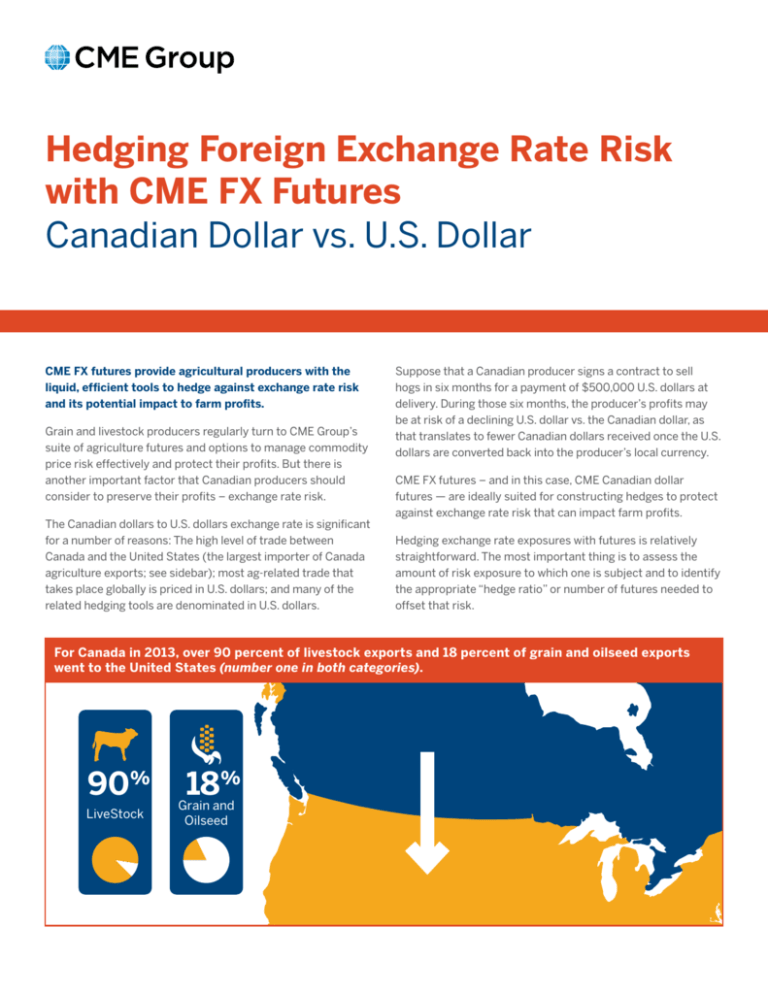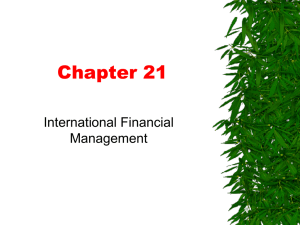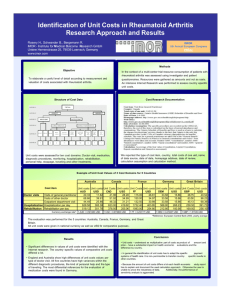
Hedging Foreign Exchange Rate Risk
with CME FX Futures
Canadian Dollar vs. U.S. Dollar
CME FX futures provide agricultural producers with the
liquid, efficient tools to hedge against exchange rate risk
and its potential impact to farm profits.
Grain and livestock producers regularly turn to CME Group’s
suite of agriculture futures and options to manage commodity
price risk effectively and protect their profits. But there is
another important factor that Canadian producers should
consider to preserve their profits – exchange rate risk.
The Canadian dollars to U.S. dollars exchange rate is significant
for a number of reasons: The high level of trade between
Canada and the United States (the largest importer of Canada
agriculture exports; see sidebar); most ag-related trade that
takes place globally is priced in U.S. dollars; and many of the
related hedging tools are denominated in U.S. dollars.
Suppose that a Canadian producer signs a contract to sell
hogs in six months for a payment of $500,000 U.S. dollars at
delivery. During those six months, the producer’s profits may
be at risk of a declining U.S. dollar vs. the Canadian dollar, as
that translates to fewer Canadian dollars received once the U.S.
dollars are converted back into the producer’s local currency.
CME FX futures – and in this case, CME Canadian dollar
futures — are ideally suited for constructing hedges to protect
against exchange rate risk that can impact farm profits.
Hedging exchange rate exposures with futures is relatively
straightforward. The most important thing is to assess the
amount of risk exposure to which one is subject and to identify
the appropriate “hedge ratio” or number of futures needed to
offset that risk.
For Canada in 2013, over 90 percent of livestock exports and 18 percent of grain and oilseed exports
went to the United States (number one in both categories).
90%
LiveStock
18%
Grain and
Oilseed
Following are two examples illustrating how to use CME Canadian Dollar (CAD/USD) futures to construct the proper hedges for
your needs to manage rate risk.
EXAMPLE: Hedge CAD/USD Exchange Rate Risk on a Live Cattle Delivery to a U.S. Firm
Assume it is April 1. You are a Canadian farmer and have just signed a contract to sell 800,000 pounds of live cattle to a U.S. firm,
deliverable on the following September 1. You will be paid on the delivery date in U.S. dollars, at an agreed-upon price of $1.650000
USD per pound ($1,320,000 U.S. dollars).
On April 1, the USD-CAD exchange rate is 1.1111 Canadian dollars per one U.S. dollar. So between April 1 and September 1, you
will be “long” the $1,320,000 U.S. dollars (USD/CAD) that you have agreed to take as payment for your cattle, and “short” the
$1,466,652 CAD that you could expect to receive if your were exchanging USD for CAD on April 1. Live Cattle Sale Details
Dates
Contract entered on April 1: Payment due on delivery September 1 in U.S. dollars
Price
Rate: $1.6500000 USD per pound, for 800,000 lbs. of Live Cattle). =$1,320,000 USD
Spot exchange rate on April 1
USD/CAD spot value: 1.1111 CAD per 1.0 USD, or
CAD/USD spot value: 0.9 USD per 1.0 CAD
Value of Contract in CAD on April 1
1.1111 CAD x. $1,320,000 USD = C$1,466,652 CAD, your risk exposure
CME Canadian Dollar (CAD/USD) Futures
Standard and E-micro Contract Sizes
Standard CAD/USD futures: 100,000 Canadian dollars /contract
Two Contract Sizes
E-micro CAD/USD futures: 10,000 Canadian dollars/contract (1/10th of the standard contract)
Contract Months
March quarterly cycle (March, June, Sep, Dec)
Contract Value
If USD/CAD = 0.9524, then:
Standard: Contract = $95,240 USD E-micro: Contract = $9,524 USD
Minimum Tick Size
Standard: 0.0001 per CAD (=$10.00 USD) E-micro: 0.0001 per CAD (=$1.00 USD)
The exchange rate could fluctuate a great deal during those five months. CME Canadian dollar (CAD/USD) futures can be
used to help mitigate risk of an unfavorable move. Start by calculating the hedge ratio. The formula for this is:
Hedge ratio
= Value of Risk Exposure / Futures Contract Size
In this scenario, the value of your risk exposure is 1,466,652 CAD, and the size of CME one CAD/USD contract is 100,000 CAD.
Plug these numbers into the formula to get:
Hedge ratio = 1,466,652 CAD / 100,000 CAD
= 14.67
It would take 14.67 standard CME CAD/USD futures to hedge the risk exposure, if only standard-size contracts were available.
In this case, however, CME offers CAD/USD futures in two sizes: Standard (100,000 CAD) and E-micro (10,000 CAD), valued
at 1/10th of the standard contract. With this in mind, take another look at the 14.67 hedge ratio:
Hedge ratio
= 14.67
Rounded up to nearest 10th
= 14.70 (14 and 7/10ths)
= 14 standard CME CAD/USD futures and
7 E-micro CME CAD/USD futures
To hedge your exposure risk, you will need 14 CME CAD/USD and 7 E-micro CAD/USD futures.
How the Hedge Plays Out: Two Scenarios
Consider the results of this hedge in two different market scenarios:
Scenario 1: CAD has rallied 5 cents vs. (declining) USD
Spot CAD/USD
USD/CAD rate
C$ value of $1,320,000 USD payment
Sep CAD/USD Futures
April 1
0.9000
1.1111
C$1,466,652
Buy
Sep 1
0.9500
1.0526
C$1,389,432
Sell
(C$77,220)
500 point increase:
$73,500 USD, or C$77,366.10
14 Standard @ .9000
7 E-micro @ .9000
14 Standard @ .9500
7 E-micro @ .9500
Future position gain in C$77,366.10 - C$77,220 spot value loss = Net Gain of C$146.10
In Scenario 1, the CAD/USD rate has moved up by 5 cents vs USD, from 0.9000 on April 1 to 0.9500 on September 1. That equals a
500 point move ($0.0001 per CAD increments).
500 x $10 per contract for Standard CAD/USD x 14 standard contracts =$70,000 USD
500 x $1 per contract for E-micro CAD/USD x 7 E-micro contracts =$3,500 USD
Total gain on your futures position =$73,500 USD
Converted into CAD (at Sep 1 conversion rate of 1.0526) = C$77,366.10
So although the underlying spot market value of your contact payment has declined by C$ 77,220, by hedging the exchange rate
exposure, you have negated the relative value loss and come out ahead by C$146.10, ensuring the value of your original contract.
Scenario 2: CAD has fallen 5 cents vs. (appreciating) USD
April 1
Sep 1
Spot CAD/USD
USD/CAD rate
C$ value of $1,320,000 USD payment
Sep CAD/USD Futures
0.9000
1.1111
C$1,466,652
Buy
0.8500
1.1765
14 Standard @ .9000
7 E-micro @ .9000
14 Standard @ .8500
$1,552,980
Sell
+ C$ 86,328
500 point decline:
($73,500 USD), or (C$ 86,472.75)
7 E-micro @ .8500
C$ 86,328 spot value gain – C$ 86,472.75 futures position loss = Net Loss of C$144.75
In Scenario 2, the CAD/USD rate has fallen 5 cents vs. USD, from 0.9000 on April 1 to 0.8500 on September 1. As in the previous
scenario, that again equals a 500 point move ($0.0001 per CAD increments) in the futures position, this time in the other direction
500 x $10 per contract for Standard CAD/USD x 14 standard contracts =$70,000 USD
500 x $1 per contract for E-micro CAD/USD x 7 E-micro contracts =$3,500 USD
Loss in value for futures position =$73,500 USD
Converted into CAD at Sep 1 conversion rate of 1.1765 = C$86,472.75
The loss on the futures position is mostly offset by the increase in spot market value of the payment, resulting in a small loss
of C$144.75. But compared to the risk of a C$77,220 loss in an unhedged position had the spot market turned against you, the
amount is relatively minimal.
EXAMPLE: Hedge CAD/USD Exchange Rate Risk on Sale of Wheat to a U.S. Firm
It is April 1. You are a Canadian wheat grower and have just sold 900,000 bushels of wheat to a U.S. firm for delivery on September
1. The price is $5.00 USD/ bushel, or $4,500,000 USD total, and you will be paid upon delivery.
The USD-CAD exchange rate on April 1 is still 1.1111 (Canadian dollars per one U.S. dollar), making the value of your contract at
signing C$4,999,950 CAD. Therefore, between April 1 and September 1, you will be “long” U.S. dollars ($4,500,000 USD) and
exposed to fluctuations in the Canadian dollar vs. U.S. dollar.
Sale Details
Dates
Contract signed April 1: Payment due upon delivery September 1,in U.S. dollars
Price
$5.00 USD per bushel, 900,000 bushels of wheat =$4,5000,000 USD
Spot exchange rate on April 1
Value of Contract in CAD on April 1
USD/CAD spot value: 1.1111 CAD per 1.0 USD, or
CAD/USD spot value: 0.9 USD per 1.0 CAD
1.1111 CAD x. $4,500,000 USD = C$4,999,950 CAD, your risk exposure
CME Canadian Dollar (CAD/USD) Futures
Standard and E-micro Contract Sizes
Two Contract Sizes
Standard CAD/USD futures: 100,000 Canadian dollars /contract
Contract Months
$5.00 USD per bushel, 900,000 bushels of wheat =$4,5000,000 USD
Contract Value
If USD/CAD = 0.9524, then standard contract = $95,240 USD
Minimum Tick Size
Standard: 0.0001 per CAD (=$10.00 USD)
You can use CME CAD/USD futures to help lock in the value of your contract and mitigate exchange rate risk. To start, calculate the
hedge ratio:
Hedge ratio = Value of Risk Exposure / Futures Contract Size
Hedge ratio = C$4,999,950 CAD / 100,000 CAD
= 49.99, rounded up to 50
To hedge your risk exposure, you will need 50 standard CME CAD/USD futures contracts.
How the Hedge Plays Out: Two Scenarios
Consider the results of this hedge in two different market scenarios:
Scenario 1: CAD has rallied 5 cents vs. (declining) USD
Spot CAD/USD
USD/CAD rate
C$ value of $4,500,000 USD payment Sep CAD/USD Futures Position*
April 1
0.9000
1.1111
C$4,999,950
Buy
50 Standard @ .9000
Sep 1
0.9500
1.0526
C$4,736,700
Sell
Sell 50 Standard @ .9500
(C$ 263,250)
500 point increase:
+$250,000 USD , or
+C$ 263,150
Future position gain in C$ 263,150 – C$263,250 loss in spot value = Net Loss of C$100
In Scenario 1, the CAD/USD rate has risen by 5 cents vs. USD, from 0.9000 on April 1 to 0.9500 on September 1. That equals a 500
point move ($0.0001 per CAD increments).
500 x $10 per contract for Standard CAD/USD x 50 standard contracts =$250,000 USD
Converted into CAD (at Sep 1 conversion rate of 1.0526) = C$263,150
By hedging your exchange rate risk with the futures, even though the underlying spot market value of your contact payment has
declined by C$263,158, you have minimized the loss to C$ 0.11 CAD. That’s much more desirable than the $263,158 dent to farm
profits that you would have otherwise sustained.
Scenario 2: CAD has fallen 5 cents vs. (appreciating) USD
Spot CAD/USD
USD/CAD rate
C$ value of $4,500,000 USD payment Sep CAD/USD Futures
April 1
0.9000
1.1111
C$4,999,950
Buy
50 Standard @ .9000
Sep 1
0.8500
1.1765
C$5,294,250
Sell
14 Standard @ .8500
+C$294,300
500 point decline:
($250,000 USD), or
(C$ 294,125)
C$ 294,300 spot value gain – C$294,125 futures position loss = Net Gain of C$196
In Scenario 2, the CAD/USD rate has fallen 5 cents vs. USD, from 0.9000 on April 1 to 0.8500 on September 1. As in the previous
scenario, that again equals a 500 point move ($0.0001 per CAD increments) in the futures position, this time in the other direction
500 x $10 per contract for x 50 standard CAD/USD futures =$250,000 USD Loss
Converted into CAD at Sep 1 conversion rate of 1.1765 = C$ 294,125
The loss on the futures position is offset by the increase in spot market value of the payment. You’ve preserved the relative
value of the payment from the original date of the agreement. Although the spot market value increased in your favor in this
particular scenario, the real value of the hedge is in the assurance that you’ve protected your profit against a potential loss due to
unfavorable exchange rate moves like the one in Scenario 1.
Comparing Futures Prices and the Forward Rate
For simplicity, in the examples used to illustrate the benefits of
the futures hedge, the FX futures prices used were the same as
the spot rate at the time of the transaction.
In practice, there is likely to be a slight difference between
the CAD/USD futures price and spot rate. The difference
between the spot rate and the future or forward represents the
“basis,” essentially the futures price minus the spot price of
the currency pairing. The basis is driven by the same factors
that affect the price of forwards in the interbank markets – the
relationship between short-term interest rates associated
with the term and base currency. (See sidebar for more on the
difference between a future and a forward.)
Over time, the basis will tend to converge towards zero
because the impact of differential short-term rates becomes
less relevant as the futures contract expiration approaches.
Once the futures contract becomes deliverable, it becomes a
direct proxy for the spot delivery of the currency, and the basis
is said to “converge to zero.”
EXAMPLE: CAD/USD Futures basis on November 13, 2014
• USD/CAD spot rate: 1.1370
• Converted to CAD/USD equivalent spot rate: 87.95
What is the difference between a Futures
and a Forward Contract?
A future is a standardized contract and is traded and
cleared on an Exchange. The time to expiration, contract
amount as well as delivery places and dates are set for
the particular futures contract. Credit risk is mitigated
through daily mark-to-market settlements and margining
which are automatically required, reducing credit risk.
A forward carries both market risk and credit risk;
in other words, the exposure is to the default by the
counterparty who may fail to perform on a forward – the
exchange is not there to guarantee the trade as a cleared
transaction. Forwards are traded on the OTC market and
can be customized in terms of expiration and value of
the contract, whereas a futures trade takes place on an
organized exchange.
A forward contract is a private transaction. Forwards are
basically unregulated, unlike a future contract which are
regulated at the government level.
If the terms of a forward contract matched a future contract,
they would behave exactly the same as they reached
expiration. Essentially, the bespoke terms and trading venue
are what differentiate a forward from a future.
CAD/USD Futures Contract Month
Days until Contract Expiration
Futures Price on November 13
Spot – Futures price = Basis
Dec ‘14
34
87.94
87.95 – 87.94 = 0.01
Mar ‘15
125
87.69
87.95 – 87.69 = 0.26
Jun ‘15
216
87.50
87.95 – 87.50 = 0.45
Source: Data from Bloomberg and CME Group.
Despite some “noise,” these basis relationships are really
quite predictable, as dictated by the relationship between
short-term interest rates associated with the two currencies
that comprise the transaction. The reason is that arbitrageurs
monitor and promptly act upon situations where the futures
and spot prices are misaligned, quickly bringing them back in
line. As futures expiration draws closer, the basis converges
towards zero, or parity.
The following chart illustrates the prices the Dec ′14 Canadian dollar futures price from January 2, 2014 - November 13 alongside
with the Canadian dollar spot rate and their respective settlements. As you can see, they trade in parallel, and the gap between the
two (basis) narrows as the futures contract approaches expiration.
Canadian Dollar Basis
95.00
94.00
Futures Price
93.00
92.00
91.00
90.00
89.00
88.00
2Ja
n
16
-J
an
30
-J
a
13 n
-F
eb
27
-F
e
13 b
-M
a
27 r
-M
a
10 r
-A
pr
24
-A
p
8- r
M
ay
22
-M
a
5- y
Ju
n
19
-J
un
3Ju
l
17
-J
ul
31
-J
u
14 l
-A
ug
28
-A
u
11 g
-S
e
25 p
-S
ep
9O
c
23 t
-O
c
6- t
N
ov
87.00
Futures
Spot adj
Source: Data from Bloomberg and CME Group.
Your broker can help you to accommodate for any basis-related risk in your futures hedge.
Summary
CME Canadian Dollar (CAD/USD) futures provide liquid, effective tools that Canadian producers can use to tailor hedges to their
needs to mitigate their foreign exchange rate risk.
For more information, contact a member of the CME FX team at fxteam@cmegroup.com or
visit cmegroup.com/fx.
CME GROUP HEADQUARTERS
CME GROUP GLOBAL OFFICES
20 South Wacker Drive
Chicago, Illinois 60606
cmegroup.com
Chicago New York
+1 312 930 1000
+1 212 299 2000
London
+44 20 3379 3700
Singapore
Calgary
Hong Kong
+65 6593 5555
+1 403 444 6876
+852 2582 2200
Houston
São Paulo
Seoul
+1 713 658 9292
+55 11 2565 5999
+82 2 6336 6722
Tokyo
Washington D.C.
+81 3242 6232
+1 202 638 3838
Futures trading is not suitable for all investors, and involves the risk of loss. Futures are a leveraged investment, and because only a percentage of a contract’s value is required to trade, it is possible to lose more
than the amount of money deposited for a futures position. Therefore, traders should only use funds that they can afford to lose without affecting their lifestyles. And only a portion of those funds should be devoted
to any one trade because they cannot expect to profit on every trade.
CME Group® is a registered trademark of Chicago Mercantile Exchange Inc. The Globe logo, Globex, CME and Chicago Mercantile Exchange are trademarks of Chicago Mercantile Exchange Inc.
The information within this brochure has been compiled by CME Group for general purposes only and has not taken into account the specific situations of any recipients of this brochure. CME Group assumes no
responsibility for any errors or omissions.
Additionally, all examples in this brochure are hypothetical situations, used for explanation purposes only, and should not be considered investment advice or the results of actual market experience. All matters
pertaining to rules and specifications herein are made subject to and are superseded by official CME rules. Current CME rules should be consulted in all cases before taking any action.
Copyright © 2014 CME Group. All rights reserved.
PM1240/00/1114






